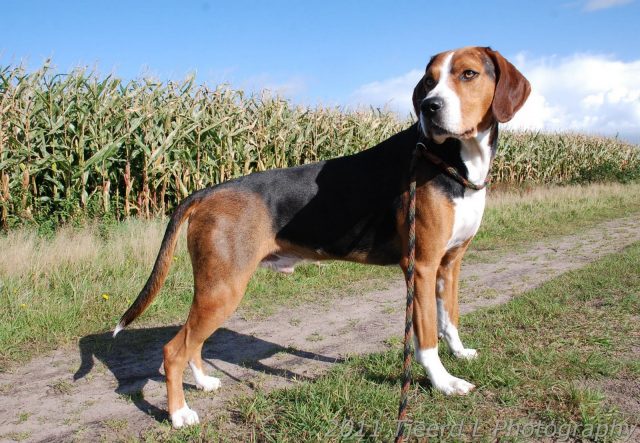Type the name of the breed you're looking for below
[wpdreams_ajaxsearchlite] Don't see the breed your're looking for? Click here and let us know!
Breed Characteristics
1 paw - breed exhibits the least amount of this characteristic
5 paws - breed exhibits most amount of this characteristic
Hamilton Hound
| Other Names | Hamiltonstövare, Swedish Foxhound |
| Nicknames | Hamilton |
| Country of Origin | Sweden |
| Weight | 50 - 60 lbs. (22.7 - 27.2 kg) |
| Height (at withers) | Females: 18 - 22.5 in. (46 - 57 cm) Males: 19.5 - 23.5 in. (50 - 60 cm) |
| Coat | Coat consists of two layers. Undercoat short, close and soft, especially thick during winter. Upper coat strongly weather-resistant lying close to body. On underside of tail, ordinary hair quite long but not forming a fringe. Ample hair between pads. |
| Colour | Upper side of neck, back, sides of trunk and upper side of tail black. Head and legs, as well as side of neck, trunk and tail brown. White markings as follows: blaze on upper part of muzzle, underside of neck, breast and tip of tail, lower legs and feet. A mixture of black and brown undesirable, as is a preponderance of any of the three permissible colours. |
| Litter Size | 3 - 6 puppies |
| Life Span | 12 - 14 years |
| Origin & History | Bred in Sweden by Count Hamilton, who wanted a single hunter of fox in hare. They were developed from German hounds and English Foxhounds. |
| Personality | Hamilton Hounds are very easy going, but can be stubborn. They are very patient with children. This breed makes a fantastic hunter as it has a very high prey drive, so caution needs to be taken with small animals. Owners must provide plenty of daily exercise, and be the dog's firm, but calm, confident, consistent pack leader to avoid behavior issues. |
Care Requirements
| Health | Hip dysplasia (very low instances) and epilepsy (very low instances). |
| Grooming | Very easy, very little shedding, bathe once a month. |
| Exercise | This dog has a lot of endurance. They need to be taken on a daily, brisk, long walk, jog or run alongside you when you bicycle. While out on the walk the dog must be made to heel beside or behind the person holding the lead, as instinct tells a dog the leader leads the way, and that leader needs to be the human. Teach them to enter and exit door and gateways after the humans. They should NEVER be left off leash unless in a secure area, as they have a tendency to run off trailing scents. |
| Other Considerations | They are very adaptable and will suit any environment, given they have enough exercise. |



